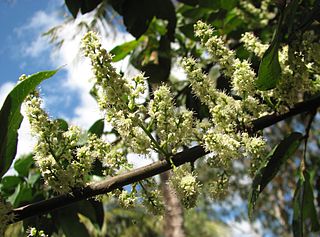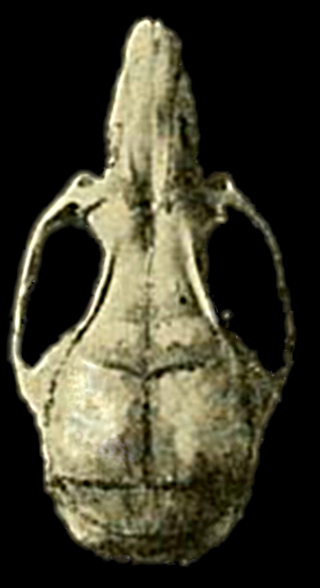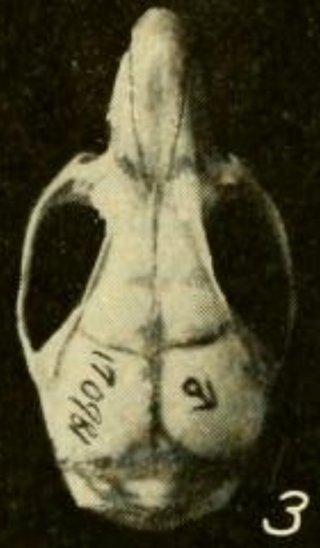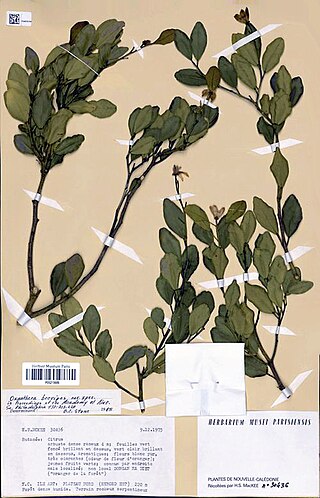
Guioa is a genus of about 78 rainforest tree species known to science, which constitute part of the plant family Sapindaceae. They have a wide distribution, ranging from throughout Malesia, in Burma, Cambodia, Vietnam, Thailand, Malay Peninsula, Borneo, Sumatra, Philippines, Java, Flores, Timor, Sulawesi, Moluccas, New Guinea, further southwards through the east coast of Queensland and New South Wales, Australia and further eastwards to the Pacific Islands, including Tonga, New Caledonia, Fiji and Samoa.

Euryoryzomys emmonsae, also known as Emmons' rice rat or Emmons' oryzomys, is a rodent from the Amazon rainforest of Brazil in the genus Euryoryzomys of the family Cricetidae. Initially misidentified as E. macconnelli or E. nitidus, it was formally described in 1998. A rainforest species, it may be scansorial, climbing but also spending time on the ground. It lives only in a limited area south of the Amazon River in the state of Pará, a distribution that is apparently unique among the muroid rodents of the region.
This article is a list of biological species, subspecies, and evolutionary significant units that are known to have become extinct during the Holocene, the current geologic epoch, ordered by their known or approximate date of disappearance from oldest to most recent.
The Mount Pirri isthmus rat is a species of rodent in the family Cricetidae.

Transandinomys bolivaris, also known as the long-whiskered rice rat, is a rodent in the family Cricetidae. It is found in humid forest from northeastern Honduras to western Ecuador, up to 1,800 m (5,900 ft) above sea level. Since it was first described in 1901 from Ecuador, six scientific names have been introduced for it, but their common identity was not documented until 1998 and the species has long been known under the name Oryzomys bombycinus, described from Panama in 1912. The name Oryzomys bolivaris was used before it was moved to the new genus Transandinomys with Transandinomys talamancae in 2006.

Transandinomys talamancae is a rodent in the family Cricetidae that occurs from Costa Rica to southwestern Ecuador and northern Venezuela. Its habitat consists of lowland forests up to 1,500 m (5,000 ft) above sea level. With a body mass of 38 to 74 g, it is a medium-sized rice rat. The fur is soft and is reddish to brownish on the upperparts and white to buff on the underparts. The tail is dark brown above and lighter below and the ears and feet are long. The vibrissae (whiskers) are very long. In the skull, the rostrum is long and the braincase is low. The number of chromosomes varies from 34 to 54.

Carpoxylon macrospermum is a species of palm tree endemic to Vanuatu, and the only species in the genus Carpoxylon.

Jubaeopsis caffra, the Pondoland palm, is a flowering plant species in the palm family (Arecaceae). It belongs to the monotypic genus Jubaeopsis.

Khaya senegalensis is a species of tree in the Meliaceae family that is native to Africa. Common names include African mahogany, dry zone mahogany, Gambia mahogany, khaya wood, Senegal mahogany, cailcedrat, acajou, djalla, and bois rouge.

Lasiochlamys hurlimannii is a species of flowering plant in the family Salicaceae. It is endemic to New Caledonia.
Lasiochlamys is a genus of flowering plants endemic to New Caledonia in the family Salicaceae. Molecular phylogenetic analysis suggest that Lasiochlamys may be nested in the more widespread genus Xylosma.
Lasiochlamys mandjeliana is a species of flowering plant in the family Salicaceae. It is endemic to New Caledonia.
Citrus oxanthera, synonym Oxanthera aurantium, is a species of plant in the family Rutaceae. Sometimes referred to commonly as the orange-flowered oxanthera, it is endemic to New Caledonia.
The false oranges are a group of flowering plants in the Citrus genus, within the family, Rutaceae. They are endemic to New Caledonia.

Oxanthera brevipes is a species of plant in the family Rutaceae. It is endemic to New Caledonia. It was proposed as a novel species by Benjamin C. Stone based on two specimens, distinguished from other false oranges by a non-articulated petiole. The genus Oxanthera has been synonymized with Citrus, but a name in Citrus does not appear to have been published, and Plants of the World Online regards "Oxanthera brevipes" as an unplaced name.
Citrus neocaledonica, synonym Oxanthera neocaledonica, the large leaf oxanthera, is a species of plant in the family Rutaceae. It is endemic to New Caledonia.
The Lake Baikal mountain vole or Olkhon mountain vole is a species of rodent in the family Cricetidae. It is found principally on the Olkhon and Ogoi islands on Lake Baikal, in southern Siberia. While it was originally described as a species, Pavlinov and Rossolimo reassigned it as a subspecies of A. tuvinicus in 1987 before reinstating it as a species in 1998.

Transandinomys is a genus of rodents in the tribe Oryzomyini of family Cricetidae. It includes two species—T. bolivaris and T. talamancae—found in forests from Honduras in Central America south and east to southwestern Ecuador and northwestern Venezuela in northern South America. Until 2006, its members were included in the genus Oryzomys, but phylogenetic analysis showed that they are not closely related to the type species of that genus, and they have therefore been placed in a new genus. They may be most closely related to genera like Hylaeamys and Euryoryzomys, which contain very similar species. Both species of Transandinomys have had eventful taxonomic histories.
Oxera baladica is a species of flowering plant in the family Lamiaceae. It comprises two subspecies, both of which are included as vulnerable species on the IUCN Red List:











